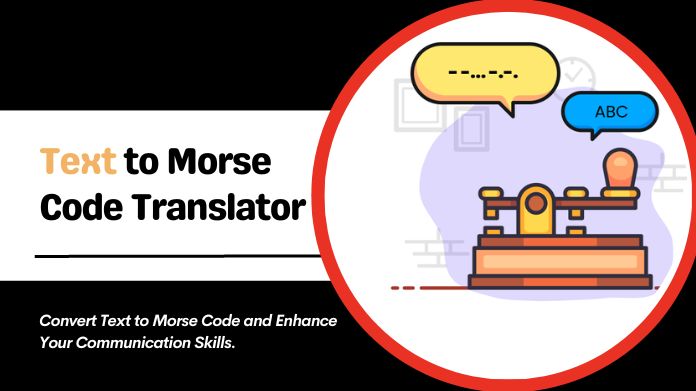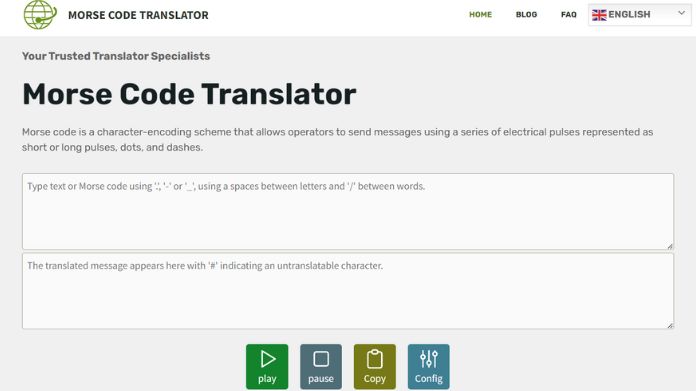In the world of communication, Morse code has a special place, offering a timeless way to convey messages through dots and dashes.
Today, we explore the charm of Morse code with a modern twist—the Text to Morse Code Translator.
Join us in unraveling the secrets of Morse code, understanding its history, and discovering how these translators bring a touch of tradition to our digital conversations.
Whether you’re a language lover or just curious, let’s dive into the fascinating world where technology meets the rhythmic language of dots and dashes.
Understanding Morse Code Communication
Morse code is a form of communication that employs a sequence of dots and dashes to represent letters, numbers, and other characters. Samuel Morse and Alfred Vail developed it in the 1830s, and it became widely used in telegraph systems.
In Morse code, each letter is defined by a unique combination of dots and dashes. For example, “A” is represented by a dot followed by a dash, while “B” is represented by a dash followed by three dots. The timing between each dot or dash is essential, as it determines the length of each character.
While Morse code is no longer widely utilized for communication, it remains an essential skill for amateur radio operators and enthusiasts. It can also be helpful in emergencies or situations where other forms of communication are unavailable.
Overall, understanding Morse code communication requires knowledge of the symbols and their corresponding letters and practice in listening and interpreting transmissions. With these skills, one can effectively communicate using Morse code.
The Role of Text to Morse Code Translator

The role of a text to Morse code translator is to convert text messages into Morse code. Morse code is a communication process that uses dots and dashes to convey letters and numbers.
This system was commonly used to send messages over telegraph lines, and it is still used today in certain situations, such as amateur radio communication and military operations.
The text to Morse code translator takes input in the form of text and converts each letter, number, or punctuation mark into its corresponding Morse code representation. For example, “A” is represented by a dot followed by a dash, while “B” is represented by a dash followed by three dots. Spaces are used to separate letters and words in Morse code.
The translator can be used for various purposes, such as learning Morse code, sending coded messages, or deciphering Morse code messages. It is a valuable tool for those interested in Morse code or situations requiring Morse code communication.
The role of a text to Morse code translator is to convert text messages into Morse code, allowing for efficient communication using this historic communication system.
How to Use a Text to Morse Code Translator?

To utilize a Text to Morse Code translator, follow these steps:
1. Find a reliable and user-friendly translator: Go for an online tool or mobile application that can accurately convert text to Morse Code. Make sure it has positive reviews and is easy to use. You can tap on Morse Code Translator here directly.
2. Input your desired text: Once the translator is ready, type or paste the text you want to convert into the designated input area.
3. Translate the text: After inputting your text, initiate the translation process by clicking the “Translate” or similar button. The tool will then convert your text into Morse Code.
4. Review the Morse Code output: Once the translation is complete, the tool will display the Morse Code equivalent of your text. Please take a moment to review the production and ensure its accuracy.
5. Interpret and use the Morse Code: After reviewing the translated Morse Code, you can use it as needed. You can write it down, communicate it through sound or light signals, or practice decoding it for learning purposes.
6. Double-check for accuracy: Before relying on the Morse Code translation for any critical application, it is advisable to double-check its accuracy. Cross-reference the translated Morse Code with a reliable source or seek the assistance of a Morse Code expert.
Following these steps, you can effectively use a Text to Morse Code translator and conveniently convert your text into Morse Code.
The Future of Morse Code Communication
Morse code was essential for long-distance communication, particularly for sending messages via telegraph wires. Military personnel, shipping companies, and amateur radio operators widely used it. However, as technology has progressed, Morse code has become less relevant in everyday communication.
The rise of smartphones, email, text messaging, and other digital communication platforms has made Morse code seem outdated and impractical for most people. Its use is now primarily limited to niche communities, such as amateur radio enthusiasts and certain military operations.
That being said, some proponents of Morse code still believe in its value and importance. They argue that it is a simple and reliable method of communication that can be useful in situations where other forms of communication are unavailable or unreliable, such as during emergencies or in remote areas with limited technology infrastructure.
In recent years, efforts have been made to preserve and promote Morse code as a cultural and historical communication method. Organizations like the Morse Telegraph Club and the American Radio Relay League continue encouraging its use and offering resources for learning Morse code.
While the future of Morse code communication may be uncertain, it is unlikely to regain widespread popularity in an increasingly digital world. However, it will likely continue to have a niche following among enthusiasts and may find practical applications in specific situations.
Wrapped Up!!
And there you have it—the journey through Morse code and the Text to Morse Code Translator comes to a close. It’s been a delightful exploration of a classic language that has found a new home in our digital age.
So, as you tap into the world of dots and dashes, remember that Morse code is not just a piece of history; it’s a timeless language that still has a place in our hearts.
In a world of constant change, let’s appreciate the simplicity and beauty of Morse code, connecting the past with the present in our communication adventures.
Happy Coding!
